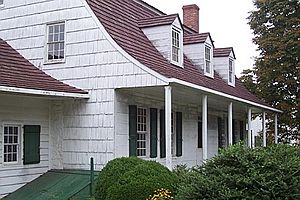Lake–Tysen House facts for kids
The Lake–Tysen House is a large, old farmhouse with special building styles from the Netherlands and Belgium. It was built by Joseph Guyon on his farm in Oakwood, Staten Island, in the United States. Many of its original wooden parts inside are still there, including fancy panels from the Georgian and Federal periods.
This house was likely home to a middle-to-upper-class family. The Lake family, who lived here, owned enslaved people. These enslaved individuals might have lived in the rooms above the kitchen.
In 1962, the house was moved from Oakwood to Historic Richmond Town, which is a living history museum. It was carefully restored and opened to the public in October 1963. The full restoration was finished in the 1970s.
Contents
Building the Lake–Tysen House
The main part of the house was built around 1740. Later, around 1820, the kitchen area was rebuilt.
The house was made with a wooden frame, using a method called the "bent system." This means large wooden pieces were put together to form the main structure. It has one and a half stories. There's also a cellar under the two main rooms and the front hallway.
The cellar walls are made from rough stones. The walls on the first floor and in the front hallways were filled with mud and straw, then covered with a plaster coat. The floors, wall panels, decorative moldings, and doors are all made of pine wood.
Where the House First Stood
The Lake–Tysen House originally sat on a large farm of 115 acres. Its first spot was about 750 feet south of Hylan Boulevard and 100 feet west of Tysens Lane, in Oakwood, Staten Island.
This area was important because it was a big, fertile farm plot. It stretched from the shoreline to a main road. This allowed for two ways to transport goods and trade them.
Before the Lake–Tysen House was built there, the land was first given to Hanse Laurense around 1677. By 1723, James Hanse Dye owned the land. Any earlier buildings on the site had been destroyed, but signs of them were found near the kitchen area.
People Who Lived Here and Their Jobs
Many different families lived in the Lake–Tysen House over the years. Here's a look at some of them and what they did:
- 1740–1758: Joseph Guyon; a farmer
- 1758–1797: The people living here during this time are not known.
- 1797–1804: Henry Barger; a farmer and a blacksmith
- 1804–1813: The Barger family; farmers
- 1813–1839: The Daniel Lake family; farmers
- 1839–1885: David J. and Elizabeth Lake Tysen; a farmer and real estate dealer
- 1885–1932: David J. Tysen II owned the house; his mother and siblings lived there.
- 1932–1937: John L. (Jack) Porter; a restaurant owner
- 1937–1962: Charles Whitaker; a real estate agent
The History of Slavery at the House
Old census records from the house show that enslaved people lived there before slavery was fully ended in New York in 1827. This is an important part of the History of slavery in New York.
Here's what some of the census records tell us:
=1800 U.S. Census (Southfield)
This record lists Henry Barregor (Barger) and his household. It shows that he owned three enslaved people.
=1820 U.S. Census (Southfield)
This record lists Daniel Lake and his household. It shows that he owned one enslaved female between 14 and 26 years old, and two enslaved males under 14 years old.
=1830 U.S. Census (Southfield)
By this time, slavery had ended in New York. This record lists people living in the house, including one free Black male and two free Black females. This shows a change from enslaved people to free people of color living in the area.
See also



